The subject of this week’s post is one of the earliest of my father’s photos as it dates from 1946. The negative is 75 years old and is not in that good a condition. The scanned image needed some processing to get it to the state you see below, and it is still rather grey with poor contrast.
The photo is from Cherry Garden Stairs, Bermondsey, looking along the river towards the City, with the dome of St Paul’s Cathedral visible through Tower Bridge.
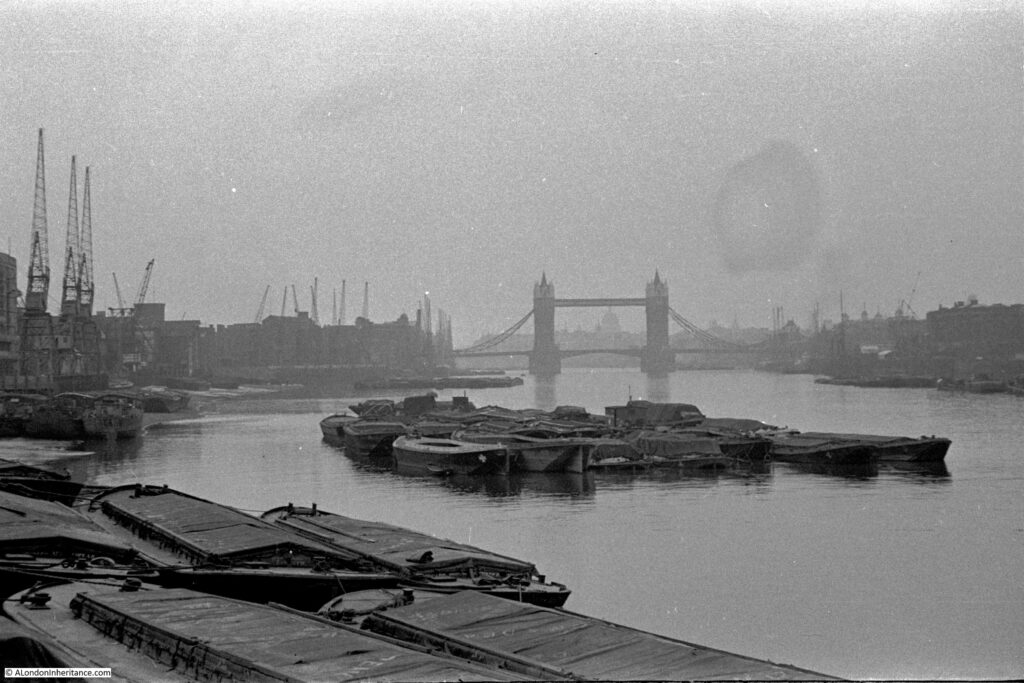
The same view today, with the dome of St Paul’s Cathedral in exactly the same place, however a very different river scene (the perspective looks different due to the very different camera and lens combinations used).
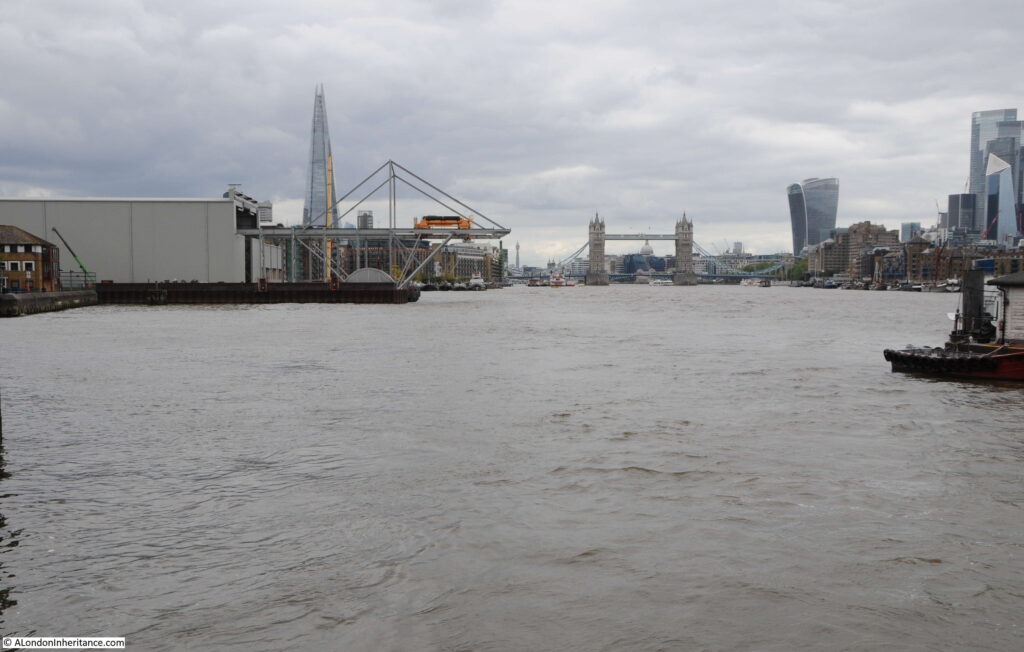
The location of Cherry Garden Stairs is shown in the following map, with the stairs located within the red circle at lower right. The 1946 photo looks along the southbank of the river towards Tower Bridge (Map © OpenStreetMap contributors).
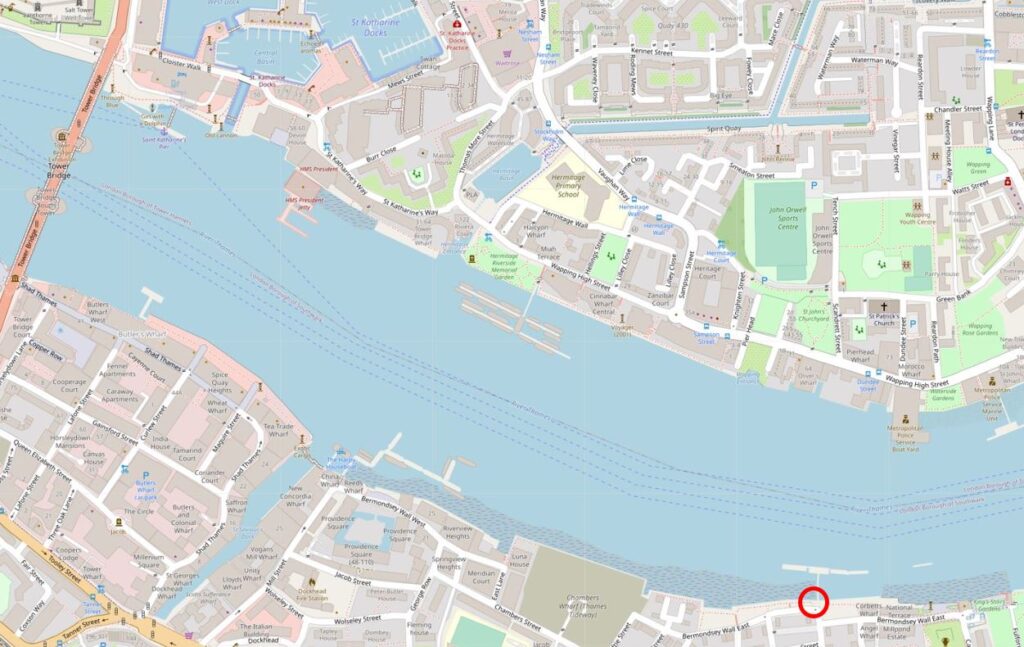
The two photos show a very different scene.
In 1946, the river bank was lined by warehouses, wharves and docks, with cranes along the river. A large number of lighters and barges are moored in the river, and directly in front of the camera, which would have been on the foreshore of the river.
In the 2021 photo the towers of the City are visible to the right, along with the Shard on the left. There are no more working warehouses, wharves or docks, and traffic on the river is today very different.
The river is though still used to transport construction equipment to a major construction site. In the 2021 there is a large shed on the left bank of the river, with the metal work of a travelling crane extending from the shed to over the river.
This is Chambers Wharf, one of the main construction sites for the Thames Tideway Tunnel. Chambers Wharf is one of the project’s main drive sites, with boring machines transported to the site via the river, and lowered by crane down to the point where the machines drive out, creating the tunnel.
Chambers Wharf was one of the many wharves between Tower Bridge and Cherry Garden Stairs. The following map is from the 1953 edition of London Wharves and Docks, and the left of the river covers the area from Tower Bridge to Cherry Garden Stairs seen in my father’s photo.
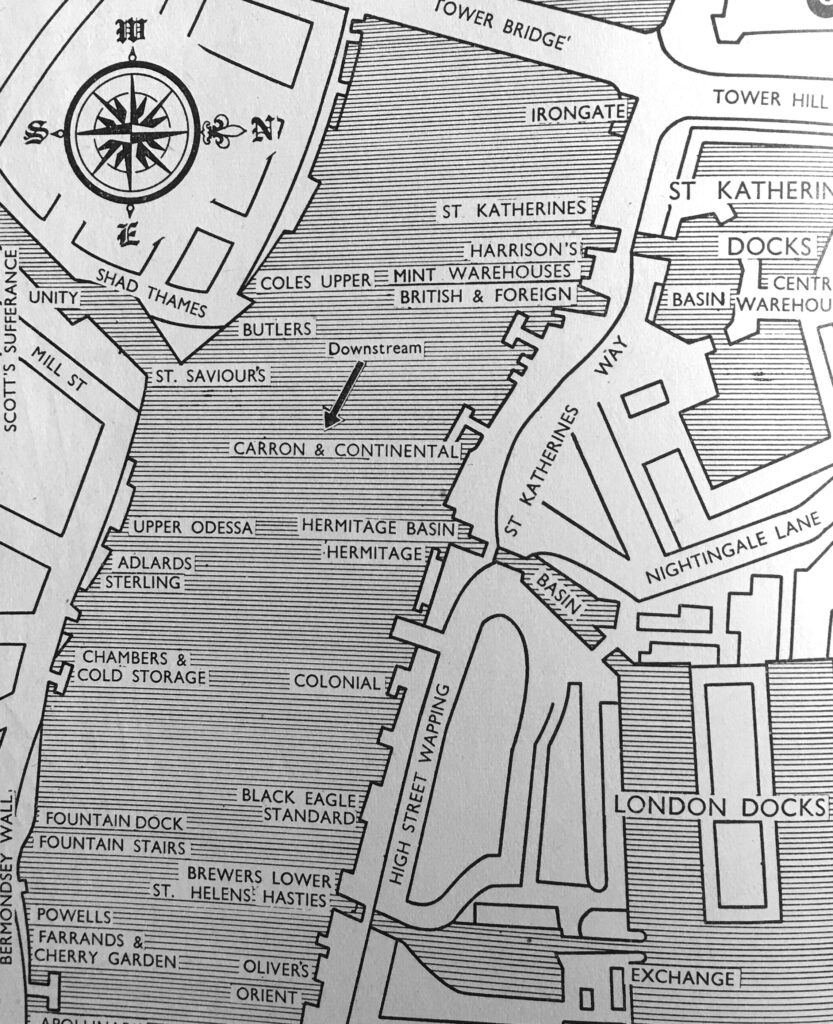
The type of goods that these wharves dealt with are (from the top of the left bank of the river):
- Coles Upper Wharf: Bulk grain, flour, cereals
- Butler’s Wharf: Tea, rubber, colonial produce, bulk grain, fresh fruit
- Upper Odessa Wharf: Cereals, non-hazardous chemicals, bagged goods
- Adlards Wharf: General and bagged goods, timber
- Sterling Wharf: General, strawboards and wood pulp boards
- Chambers Wharf and Cold Storage: All types of food including highly perishable refrigerated dairy produce and quick frozen goods
- Fountain Dock: Grabable rough goods, coal, granite, ballast and sand
- Fountain Stairs Wharf: General, flour, cased goods
- Powells Wharf: Foodstuffs
- Farrands and Cherry Garden Wharf: General goods in bags, cases and casks, flour and corn starch
Also in the above map is St Saviour’s Dock, which I will save for a future post.
The list of wharfs does show the considerable range of goods that were being handled in the stretch of the south bank of the river shown in the 1946 photo.
The following extract from the 1949 edition of the Ordnance Survey map shows Cherry Garden Street in the centre of the map, running up to Cherry Garden Stairs, which are at the lower left of Cherry Garden Pier (‘Reproduced with the permission of the National Library of Scotland’).
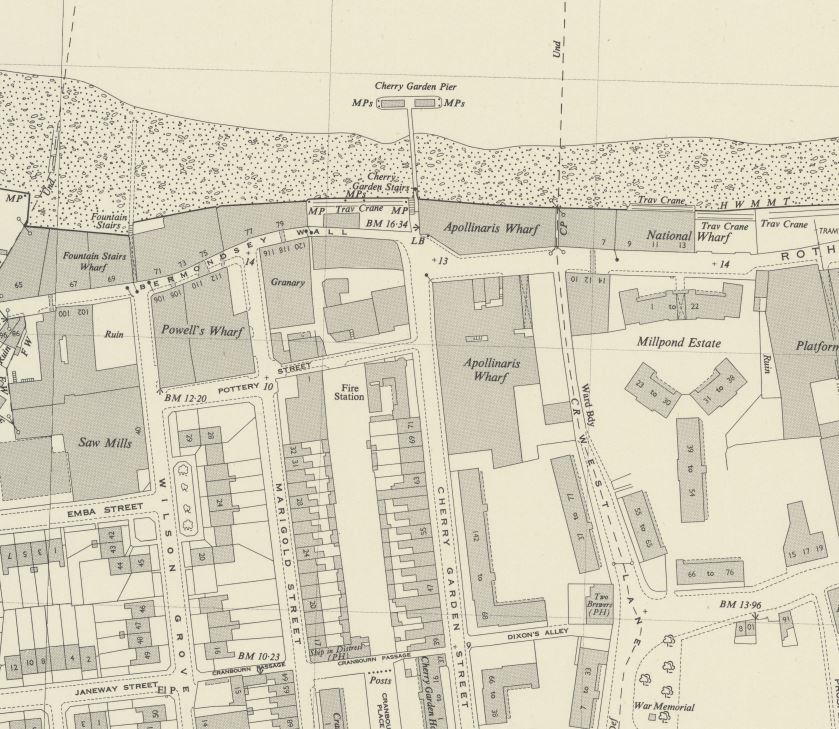
A pier at the site seems to date from the later half of the 19th century, and Cherry Garden Pier is still there today, although used by a private company with no public access.
One interesting point in the above map, is to the right of the map is the Millpond Estate, a 1930s housing development which can still be seen today. The location of the estate had been the site of a flour mill, mill pond and terrace housing. The mill pond was once part of an extensive irrigation system that ran inland to much larger ponds – lots more to discover around this part of Bermondsey.
Cherry Garden Stairs are one of the many old stairs that provided access to the river. The earliest newspaper reference I can find to the stairs dates from the 25th May 1738 when “Yesterday morning an eminent Shoemaker at Cherry Garden Stairs, Rotherhith, was found drowned in the River Thames”.
The stairs are probably much older than the 1738 reference. Leading back from the location of the stairs (see above map) is a street called Cherry Garden Street. The street is named after a pleasure garden that was here called Cherry Garden.
In volume four of the 1912 edition of the History of the County of Surrey in the Victoria County History series, there is reference to a Jacobean style house called Jamaica House which could still be found in Cherry Garden Street until 1860.
This house appears to have been part of the gardens as in the same volume, there is a quote from Pepys which reads “To Jamaica House, where I never was before, together with my wife, and the Mercers and our two maids, and there the girls did run wagers upon the bowling green: a pleasant day and spent but little”.
Jamaica House or Tavern in 1858 (© The Trustees of the British Museum):
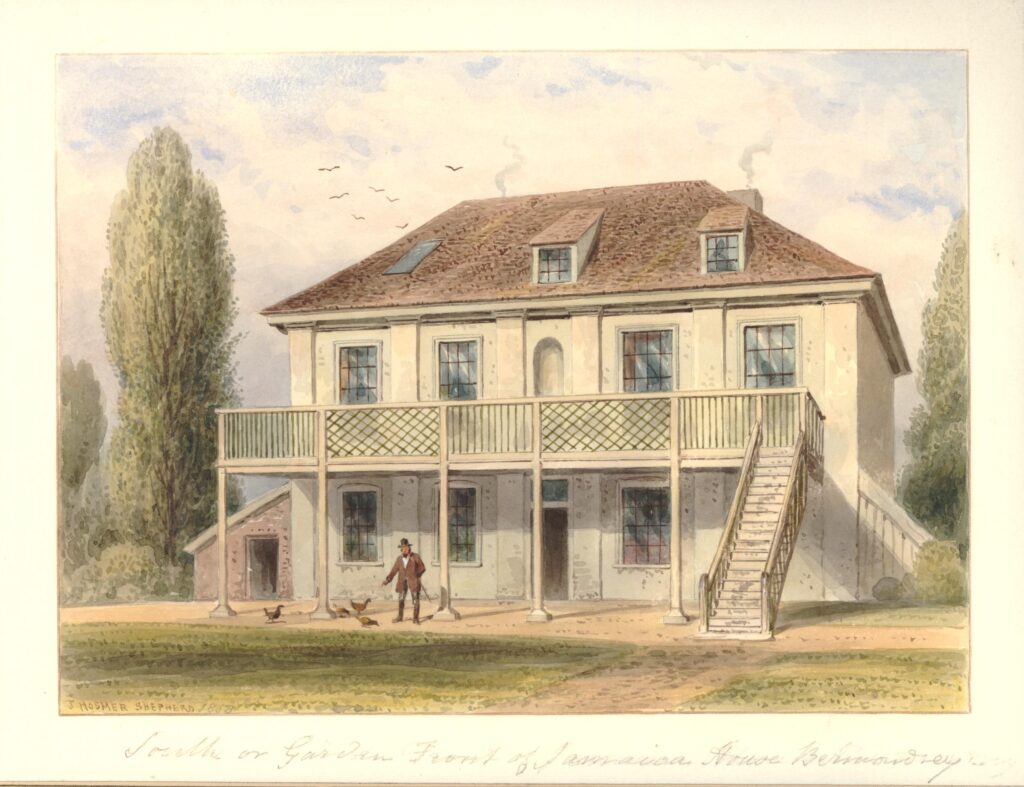
Pepys visit is referenced in an article in the Westminster Gazette on the 7th October 1910, which also recalls an inn that was located by the stairs: “Cherry Garden-street, the scene of yesterday’s big riverside fire, occupies the site and preserves the name of the old Bermondsey ‘Cherry Garden’, once a well-known place of public resort. The Cherry Garden was favourably known to Pepys, who recorded his visit there in his famous diary. At Cherry Garden Stairs there was formerly a celebrated inn known as the Lion and Castle, a name supposed to have been derived from the marriage which took place between the Royal House of Stuart and that of Spain. Close by was the even more famous Jamaica, traditionally supposed to have been the residence of Cromwell”.
Edward Walford in Old and New London (1878) doubts the Lion and Castle name originating from a Stuart / Spanish name and prefers the source to be “the brand of Spanish arms on the sherry casks, and have been put up by the landlord to indicate the sale of genuine Spanish wines, such as sack, canary and mountain”.
The Lion and Castle pub seems to have been at Cherry Garden Stairs from the late 18th century to some point around the 1860s. It was not shown on the 1895 OS map.
It may have been that the stairs were used for river access to the pleasure gardens and that was why they took the name of the gardens. Rocque’s map of London in 1746 shows Cherry Garden Stairs (right on the corner edge of my copy of the map):
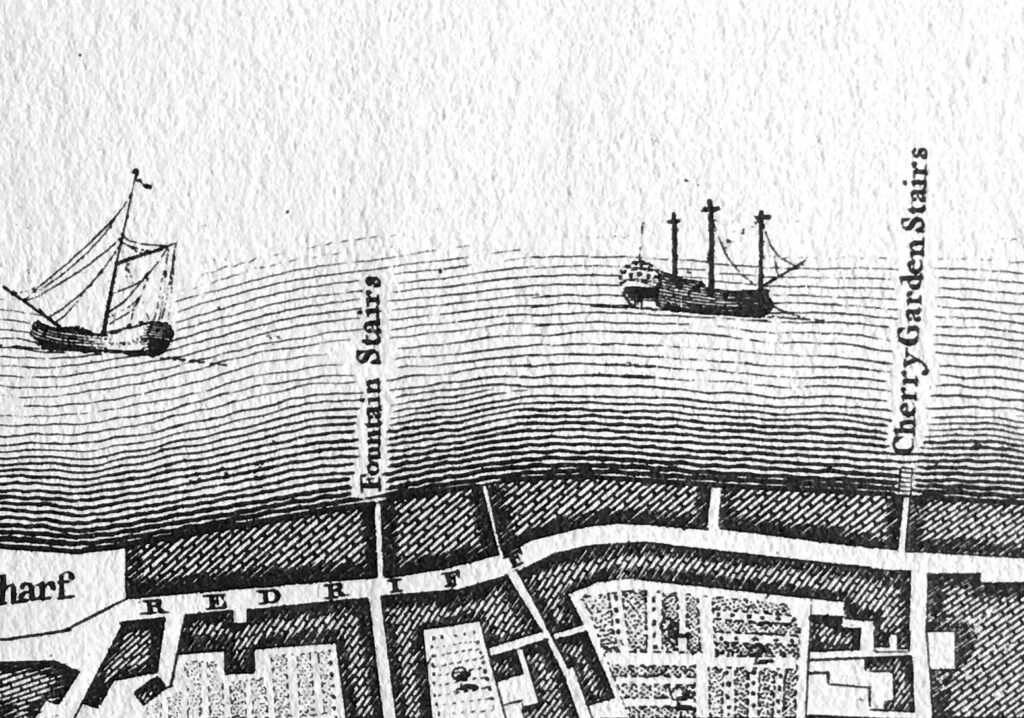
Thames stairs were so very important for centuries in the life of the river, and for all those who had some connection with the activities carried out on, or alongside the Thames.
As well as providing access to and from the river, Thames stairs were a key landmark. There are hundreds of newspaper references to Cherry Garden Stairs during the 18th and 19th centuries. The majority of these are adverts of ships for sale, for lease, or that were about to set out and were advertising for cargo or passengers.
For example, the Public Ledger and Daily Advertiser on the 8th May 1818 has the following advert: “Has only room for a few Tons of Goods, and will be dispatched immediately. For Gibraltar direct. The fine, fast-sailing Brig PRINCE REGENT, Henry Stammers, Commander. lying at Cherry Garden Stairs. burthen 118 tons. For Freight or Passage”.
Other reports concern accidents, collisions, drowning and bodies pulled from the river near the stairs. Such an incident is recorded in the last newspaper reference to the stairs that I can find, when on the 29th November 1936, Reynold’s Newspaper recorded that a ten year old Bermondsey boy had fallen into the Thames from Cherry Garden Stairs and had drowned.
Thames stairs and pubs also seem to be a magnet for crime. For example, there are reports of passengers being rowed across the Thames and then robbed in, or close by the pubs that were often located near the landside of the stairs.
The tide was in when I arrived at Cherry Garden Stairs to taken the comparison photo. Access to the foreshore is now via a modern set of metal stairs that run over the embankment wall that was built as part of the walkway / tree lined open space that runs along the river. Difficult to photograph without being on the foreshore, but the stairs can be seen at the end of the wall in the following photo:

The walkway to the pier can be seen in the background.
I am sure that my father took the original photo from the 1946 version of the stairs, as it was by standing on the stairs that I could get the dome of St Paul’s Cathedral in exactly the same position. At this distance from Tower Bridge and the cathedral, even a small change in position changed the orientation of bridge and dome.
There is much more to discover in this part of Bermondsey, so it is an area I will be returning to again.

Interesting to see the picture of Jamaica House. Although the Victoria County History calls it Jacobean style, it is almost certainly later and is more likely to have been built in the 1650s or even 1660s, to judge from the design with its pilasters and central first floor niche
At Cherry Garden Stairs in the 17th century lived James Atkinson, a mathematical instrument maker who also wrote and sold maritime books. He also had premises in St. Saviours Dock, or S. Savarisas he called it. Among his works was a text book called An Epitomy of the Whole Art of Navigation, which was still being re-printed a century later. He also expanded and updated several books by other mathematicians, such as: The Mariner’s Compass, first written by the mathematician Andrew Wakeley, and Measuring made Easy: or the Description and Use of Coggeshall’s Sliding-Rule by J. Good.
Rotherhithe was an attractive resort at that date, with market gardens and orchards, a tide mill, streams and ponds, wild birds and fish. A visit to the Cherry Gardens was a popular diversion for Londoners on a day out. Samuel Pepys wrote about a visit, in 1664: “and so to Cherry-gardens and carried some cherries home.”
An incident in Atkinson’s life was recorded in detail. On 14th September 1684 he went with his young children to the house of Captain Daniels, near West Lane in Rotherhithe, where a crowd had assembled to hear the pastor Thomas Rosewell preach. During the Restoration period such gatherings were a concern to the government, who suspected treason, so they took place in private houses. On this occasion the location of the event, the house of a Captain Daniels, was spread by word of mouth, and people were stationed at Cherry Garden Stairs to guide the congregation to the right address. Rosewell began early in the morning, and preached until early afternoon, with one break for refreshments. Briefly, to illustrate the point he was making, he mentioned the story of the wicked Kings Ahab and Ahaziah, (II Chronicles). Three women subsequently accused him of speaking ill of Kings Charles II. Whether they were paid informants or simply ignorant is unclear; one of them, a Mrs. Hilton, was a known trouble-maker.
Thomas Rosewall was arrested, imprisoned and then tried for treason at Westminster Hall before the infamous Lord Chief Justice Jefferies. James Atkinson was called twice to give evidence, despite being unwell at the time. To prove she had been present, one of the three women, Mrs. Smith, described Captain Daniels’ house and Atkinson’s children:
We were up one pair of Stairs. …we were in the Room with the Bed, and there was one Mr. Atkinson there that was in Mourning, and there were two or three Boys of his with him that sat upon the Bed, and their Shoes were plucked off, that they might not dirt the Bed, and I gave him his Boys Shoes from under the Bed.
Rosewall was not allowed Counsel, and had to conduct his own defence. He pointed out serious anomalies between the Indictment, which was written in debased legal Latin, and the English; for example the disease commonly known as King’s Evil had been translated, not as scrofula, but as Morbus Regni Anglici – the disease of the English Kingdom.
Atkinson and several other witnesses testified as to their understanding of what Rosewall had actually said. He had not taken notes on the day, but when he heard Rosewall had been arrested he had written down what took place. He also had a notebook in which he had recorded the conventicles he had attended and where they had taken place. At one point Atkinson ‘ seem’d a little faint and stopp’d’, but he recovered and was able to continue. He was able to relate the exact verses in the Bible that formed the basis of the sermon, commenting: ‘ I thank God I have a pretty good memory.’
Although Rosewall had turned from the rituals of the established church, into which he had been ordained, to Puritanism, he had a life-long fondness for the King. A large number of people testified that they had never known him speak ill of the King, and that he never failed to pray for him. Nevertheless, Judge Jefferies was determined he should suffer the death penalty for treason – to be hanged, drawn and quartered – and directed the jury in such a way that they had no option but to find him guilty. He did concede however that sentence should be deferred so that counsel’s opinion could be received. This did not turn out any better for Rosewall, but such was the disquiet about the case among the public, Anglican and Presbyterian alike, that the King intervened and granted him a pardon.
One of the little boys whose shoes had to be taken off must have been four-year-old Benjamin Andrewes Atkinson, who grew up to become a Dissenting Minister, and wrote many books. Another son, James, continued the business after the death of their father in 1719.
Jill Armstrong-bridges
My mother was Winifred Keyse her ancestor was Thomas Keyse the founder of Cherry Gardens Spa. Spa Road and Keyse Road are turnings of Grange Road where my Grandfather was born.
Thanks for another fascinating post. I’ve enjoyed walks from Surrey Docks through Rotherhithe and along Bermondsey Wall to Butler’s Wharf several times. One of these, perhaps in 2018, occurred in the wake of a post you made concerning a lost street in the vicinity of Bermondsey Wall. Your work regularly enhances my understanding and enjoyment of London, though I’m an ocean away and haven’t been able to visit in 2-1/2 years.
I’m also regularly astonished and delighted that commenters, such as Ms. Armstrong-Bridges above, can note direct familial relationships to the sites you chronicle. It must be wonderful for her to see such a connection, as it is for you literally to walk in your father’s footsteps as you revisit his photos of decades past.
That’s really interesting,Thankyou. Curious how Bermondsey sometimes had a bad reputation, when so much vital work was done here. Up to the 1970’s the river was busy. The advent of containerisation sounded the death-knell for the docks, and all the associated labour, support transport and processing. To have metal boxes travel door to door from America, Europe and the Far East also meant that water damage and “shrinkage” were eliminated, along with a lot of small sales through the street markets, and look where they have gone! Life was tougher and shorter , but there is still romance to all the activity. Remember the cranes dipping in salute to Churchill’s funeral…Thank you again for reminding us how vital the docks were to london and the nation.
Hello,
I’ve really enjoyed your blogs, and the latest about Cherry Garden Stairs in particular as I’ve spent many hours along the riverside. I have two shots from a similar viewpoint in a Flickr album which you might be interested to see:
https://www.flickr.com/photos/squeezyboy6/albums/72157713480797791/with/49658339901/
Keep up the good work.
Regards
Another belter sir. I lived in cherry garden street and this brought back memories of me falling in the Thames there as a kid in the 60’s. Keep up the good work,
I think the Dockers were paid an extra shift so they would dip the cranes for Churchill funeral good luck to them for getting it.